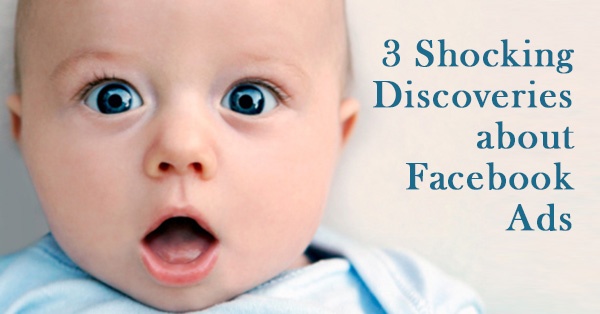
 I recently discovered 3 secrets about Facebook ads.
I recently discovered 3 secrets about Facebook ads.
And I'm finally ready to tell.
If you've ever run ads, you'll definitely want to know these.
They'll help you understand:
- What a "lead" ACTUALLY means
- The best way to measure & optimize your ROI on ads
- The REAL difference between website-click & post-engagement ads
I've done a lot of research & experiments to discover these secrets -- and my conclusions might surprise you.
Read on!
>> Click to Tweet <<
3 Shocking Discoveries About Facebook Ads That You REALLY Need to Know
1. What a "Lead" ACTUALLY Means
When it comes to Facebook ads, a lead is probably not what you think it is.
Here's a story:
A client of mine wanted to run Facebook ads to drive traffic to a web page where he installed a registration form. The form looked like any other lead magnet landing page -- or "squeeze page" as they're commonly referred to.
He was offering an information product in return for an email & phone number.
He used ShortStack to install the registration form on his Facebook page. And the conversion funnel worked the same as hosting a lead magnet page on a website:
- Facebook user > Registration form > Signup
We used website-click ads to promote the registration form & ShortStack's action & code widgets to install conversion pixels to track visits & signups.
ShortStack has a great tutorial that shows you how it's done! (well done, guys)
These were the results after a couple days running ads:

- Website clicks: 524
- Leads: 182
- Registrations: 7
So far so good, right?
But did you notice the huge disparity between the number of website clicks & leads?
Website clicks refers to the total number of clicks on a link. Leads show the number of people who visited my registration form.
>> Click to Tweet <<
Just to be sure, I looked up what Facebook says about website clicks:
The number of clicks on links appearing on your ad or page that direct people to your sites off Facebook as a result of your ad. Actions are counted when they occur within 1 day of someone viewing or 28 days after clicking on your ad.
Here's Facebook's take on leads:
The number of new leads you acquired on your website as a result of your ad. Actions are counted when they occur within 1 day of someone viewing or 28 days after clicking on your ad.
So why were there so many more website clicks than leads?
Look again at Facebook’s definition of a lead:
The number of new leads you acquired on your website …
That's right!
The number of new leads …
Facebook only tracked the new leads on my page, not recurring leads. If the same person came back to the page, that visitor was not logged as a lead!
How do I know this?
Here's what I saw when I reviewed results from when I first installed the conversion pixels:

There were 3 website clicks in the 4th row -- but no leads?!?
If the conversion pixel tracked every person who landed on my page, surely there would have been at least 1 visitor!
This helps account for the huge disparity between website clicks & leads that we saw above.
We created different ads within each ad set. But the different ads targeted the same people.
That's right, the same person could see ads A, B & C. When someone clicked ad A & landed on my web page, Facebook mapped that visit to ad A.
If the same person then clicked ad B or C & landed on my page, Facebook didn't count those visits as "new leads".
That's big!... Know why?
Imagine this was your advertising report -- with specific results for each ad in your campaign:

Put aside the registration metric for a second.
Would you optimize your ads based on website clicks or leads (conversion)?
The best answer?.... Neither!
For one, the same person could have clicked the same ad multiple times, which would explain the high number of website clicks.
If you had excluded the people who already signed up from your target audience, this means that those who clicked several times have yet to convert.
It's a waste of money to keep showing them the same ads. But optimizing your ads based on website clicks will likely keep showing the first 5 ads to these same people over & over again!
On the other hand, let’s say that Ryan, a member of your target audience, clicks the first ad but doesn't sign up on the form. But then he sees the second ad & clicks through to sign up.
Facebook would count this as 1 website click, zero leads & 1 registration.
If you had optimized the ads based on leads -- you would have removed the second ad.
Big mistake!
Now let's look at it a different way: Pretend you have a sales team who you reward for every person they bring into your store.
Applying the logic I described above, if the first salesperson gets someone through the door, but that person doesn't buy, salesperson #1 would still get rewarded.
Then when salesperson #2 gets the same person into your store a second time, and this time the customer buys, the second salesperson would not get the bonus.
That doesn't make sense!
To resolve this, you either reward both salespeople or reward none of them.
Applying this analogy to our Facebook ad campaign, you either attribute visits to the:
- registration form
- both ads
- nothing at all
Due to the nature of the conversion pixel, you pretty much have to choose option #3.
2. The Best Way to Measure & Optimize ROI
Remember that not all website clicks are created equal.
It's important to look beyond the base metrics on Facebook ads to determine their true value.
>> Click to Tweet <<
For example, when you run website-click ads with conversions in mind, review more meaningful metrics than cost per website click -- such as the cost per desired conversion (which is often leads & sales) -- especially when you’re deciding which ads to stop & which to allocate more money to.
The results might surprise you!

To optimize my ads based on leads I would probably remove all the ads from rows 7 through 11.
I wouldn’t touch the last ad because the reach was insignificant. I’d cut the ads that were leading to registrations -- such as row #11.
To optimize my ads based on cost per website click, I would remove anything that cost more than a dollar.
And I’d cut ads that were leading to signups -- such as rows 6 and 11. But none of that sounds right!
Let’s say the threshold for each email signup is $10. Judging by the above results, I’d have removed all ads except the last 2 rows.
See what I mean?
Always optimize your Facebook ads for your end goal, which in this case was registrations.
Jon Loomer explained this in more detail:

3. The REAL difference between website-click & post-engagement ads
This could get tricky so pay especially close attention to this part.
My initial findings told me that if I want to generate leads or sales on my website, it doesn’t really matter whether I choose to run post-engagement or website-click ads.
While this is sometimes true, it's not always the case.
To make use of website-conversion ads, you need to know about the conversions that are happening on your site. Only then can you optimize your Facebook ads to show them to more people who are likely to convert.
If you don't have that conversion data, the best alternative is to either run website-click ads or post-engagement ads.
Earlier findings led me to believe that post-engagement ads could perform better than website-click ads.
After all, I was mainly concerned with generating conversions on my website, which meant that I needed traffic to the site.
But the quality of that traffic matters a lot.
Website-click ads may drive more traffic, but the traffic from post-engagement ads is higher quality.
To explore this hypothesis, I ran an experiment with 2 campaign objectives:
- Post Engagement
- Website Clicks
Each campaign had 2 identical ad sets. Each ad set had almost identical ads.
Why "almost identical" and not entirely identical?
Because I couldn't create an unpublished link post to promote with the post-engagement objective. So I used a slight variation.
The ad sets were used to target 2 different groups:
- Existing website visitors (excluding email subscribers)
- Fans of competitors (excluding email subscribers)
To maintain consistency, I didn't optimize any ads, which may explain why the cost per registration was high (but that’s not the key concern for this experiment).
All ads were created as unpublished posts. Here's what the post-engagement ad looked like:

And here's a shot of the website-click ad:

Note: the actual ads had the same colors, images & copy.
Results

Here are the results (for those keeping score at home):
1. Website-Click Ad #1:
- Website clicks: 12
- Registrations: Zero
- Cost per registration: N/A
2. Website-Click Ad #2:
- Website clicks: 12
- Registrations: Zero
- Cost per registration: N/A
3. Page-Post Engagement Ad #1:
- Website clicks: 5
- Registrations: 2
- Cost per registration: $5.12
4. Page-Post Engagement Ad #2:
- Website clicks: 2
- Registrations: 2
- Cost per registration: $5.85
The website-click ads drove traffic to my site, but added no real value because they didn't convert any email subscribers.
Meanwhile, both post-engagement ads drove less website traffic but the visitors were more suited to my advertising objectives.
>> Click to Tweet <<
Fewer than half of the website visitors from the first ad converted. The conversion numbers on post-engagement ads were much higher.
In both cases, the results might not be statistically significant since the sample sizes were so small. The results might change if I had 5x or 10x the reach per ad.
That's why I chose to re-run these ads after I changed the copy & images to bring the ad cost down. I'll report back to you when I have newer results.
Since you might see different results on your page, earmark some ad spend to test whether page-post engagement or website-click ads work best for you.
You might find website-conversion ads to be the least effective.
Conclusion
The results from my Facebook ad experiments always surprise me!
There are 3 major takeaways from this article:
- When you track website conversions using lead conversion pixels, don't turn around & optimize your Facebook ads based on those results.
- Optimize your ads based on the objective that matters most to you. If you run website-click ads & track the number of visits to your website, subscribers & sales -- when possible, optimize the ads based on what drives most of your sales. If you don't have that data, work backwards & optimize for the number of subscribers & website visitors (in that order).
- Test different ad objectives! Don't assume that one is the best choice for you. Sometimes post-engagement ads return much better results than website-click ads.
I plan to conduct extensive Facebook ad experiments in 2015.
Will you be testing ads this year? If so, what will you test?
What would you like me to test next? Please share with me in the comments below.







ViewHide comments (3)